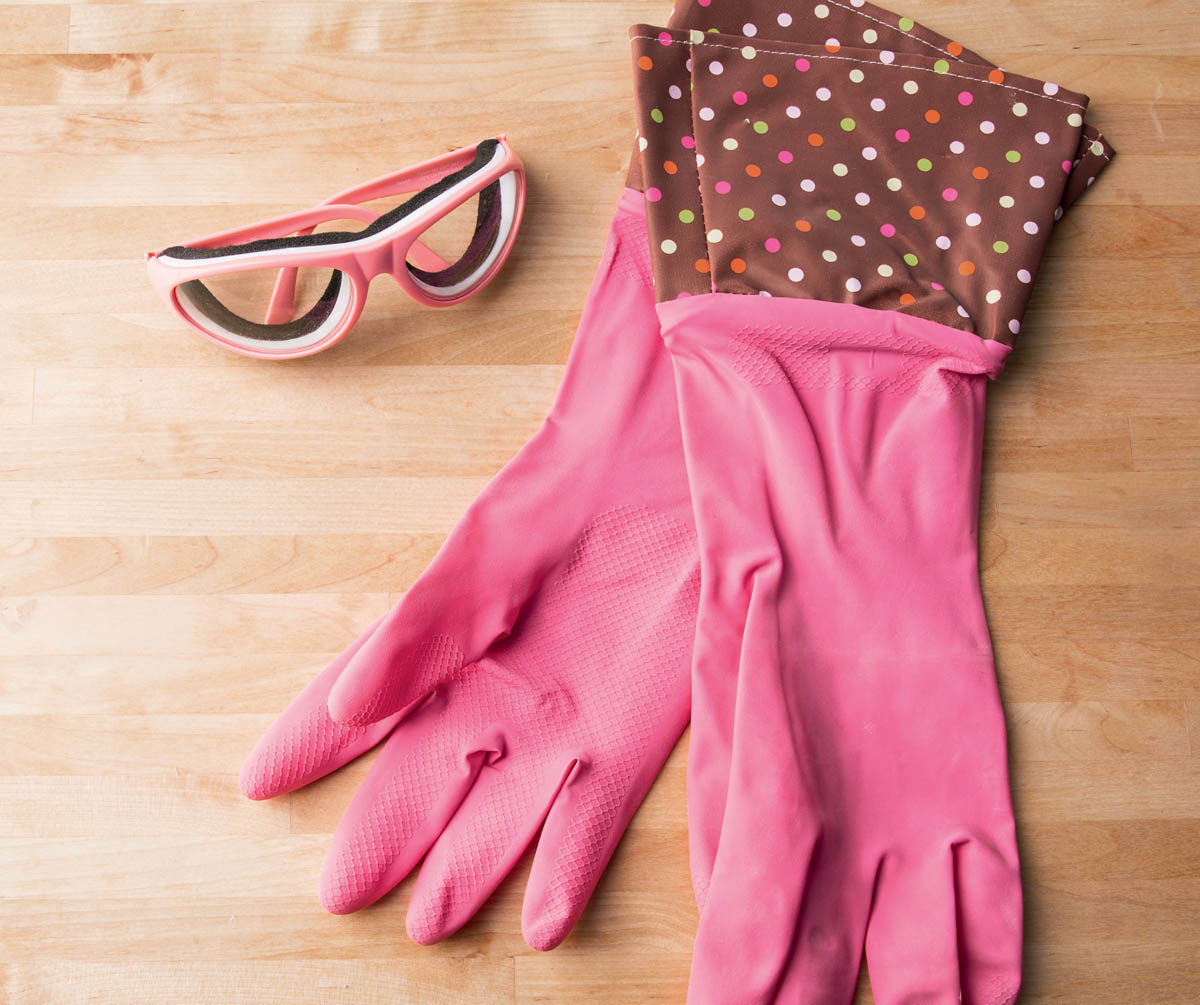
At its core, soapmaking is a science. Soap results from the chemical reaction that occurs when you combine a fatty acid (oil) with an alkaline substance (lye); the process is called saponification.
Because saponification involves caustic materials, safety precautions are critical. Please review the safety guidelines given in this chapter before starting your soapmaking journey.

There are a variety of soapmaking methods: the cold-process method, the melt-and-pour method, and the hot-process method are three of the most popular. This book deals primarily with the cold-process method, but once you’ve mastered that method you may have fun learning about the other options.
The cold-process method of making soap from scratch consists of mixing sodium hydroxide (lye) with water and then combining the lye-water solution with one or more oils until the mixture reaches a thin, pudding-like consistency in a process called tracing. At this point, you mix in colorants, fragrances, and any other additives, such as herbs or spices, and pour the traced soap into molds.
Once the soap has hardened (usually in two to three days), you can pop it out of the molds. You will have to continue drying and curing it for four to six weeks. As the soap cures, excess water evaporates and the lye and oil continue to react, making the soap milder and leaving you with an exceptionally skin-loving product.
When purchasing the materials to make soap, be careful to buy sodium hydroxide, not potassium hydroxide. It’s easy to mix them up, but they are entirely different. Using potassium hydroxide instead of sodium hydroxide will ruin your soap.
This method is called cold-process because it requires no outside heat source. Despite the name, however, there is heat generated during the process. When the lye is added to the water, the resulting exothermic (i.e., heat-producing) reaction can reach up to 200°F. That is warm enough to melt most solid oils that can be used in soapmaking; in fact, with most soapmaking techniques, the lye-water has to be set aside to allow it to cool before it is added to the oils.
Cold-process soaping is popular because you can choose recipes with whatever skin-safe ingredients you want. It does, however, have a couple of drawbacks. First, it deals with lye and so is not a suitable activity for children. Second, some soapers may get impatient with the drying and curing time.
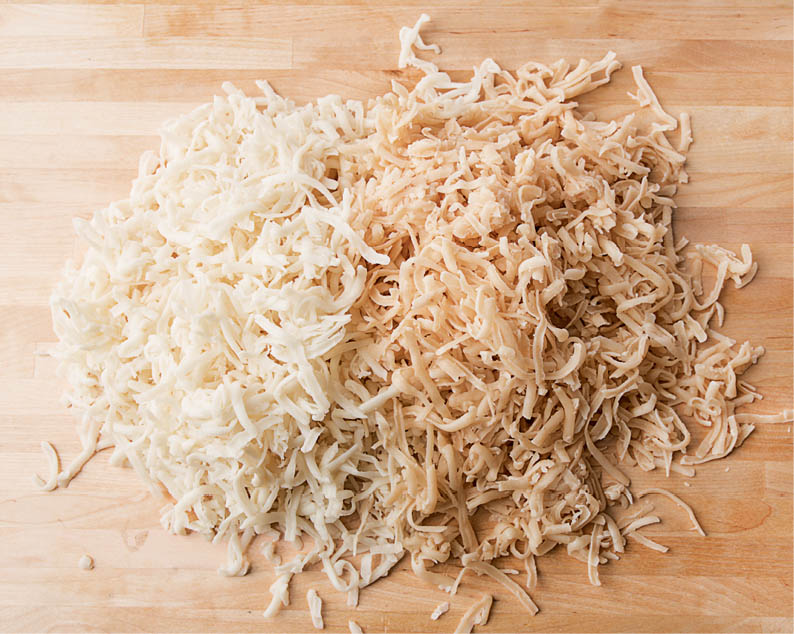
Shreds of cold-process soap
A variation of cold-process soapmaking is rebatching soap. With this method, you take shreds of cold-process soap, apply heat and some liquid, and turn the soap shreds into a new bar of soap. This method appeals to people who wish to use delicate essential oils in an all-natural recipe. The high pH of fresh cold-process soap will often damage the delicate scent and properties of some exotic essential oils. Rebatch soap allows you to have all the goodness of cold-process soap without having to worry about the safety issues involved with handling lye. The resulting product has a more rustic, rough-hewn texture than traditional cold-process soap and intricate designs are more difficult to create.
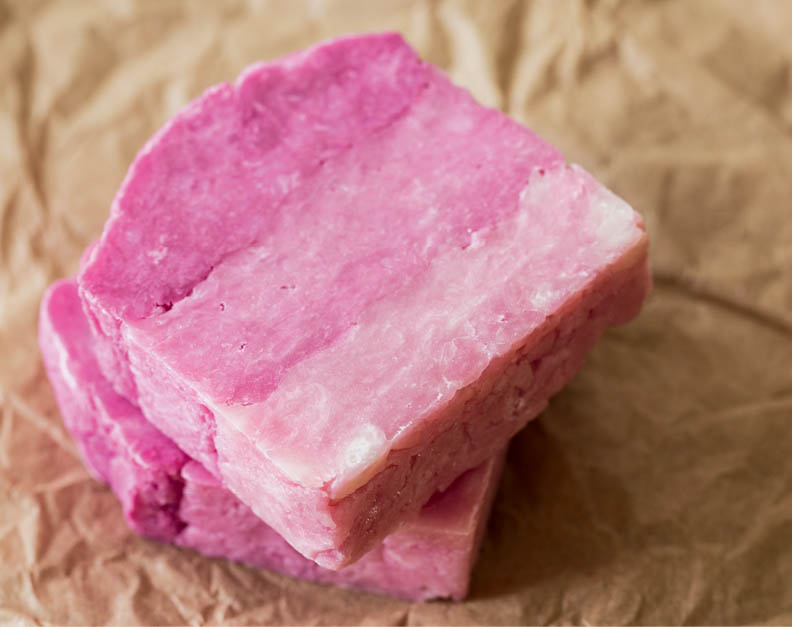
Rebatch soap
The melt-and-pour soapmaking method uses a premade soap base that melts easily. Most soapers melt the soap base in a microwave or a double boiler, though any gentle heat source — for example, a dual-temperature rice cooker — will do. Once the soap base is melted, you simply mix in colorants, fragrances, and other additives; stir well; and pour the mixture into the mold. As soon as the soap sets up (usually within an hour or two), it is ready to use.
Many soapers prefer the melt-and-pour technique because the clear or white base gives them many design options and because the end product does not need any curing or drying time. The premade base limits the choice of ingredients, but the 40 to 50 available formulations fit the vast majority of soapers’ needs. Melt-and-pour soap is also a fun craft to make with children. Though it does not use lye, the soap base can get quite hot during the melting phase, so adult supervision is recommended.
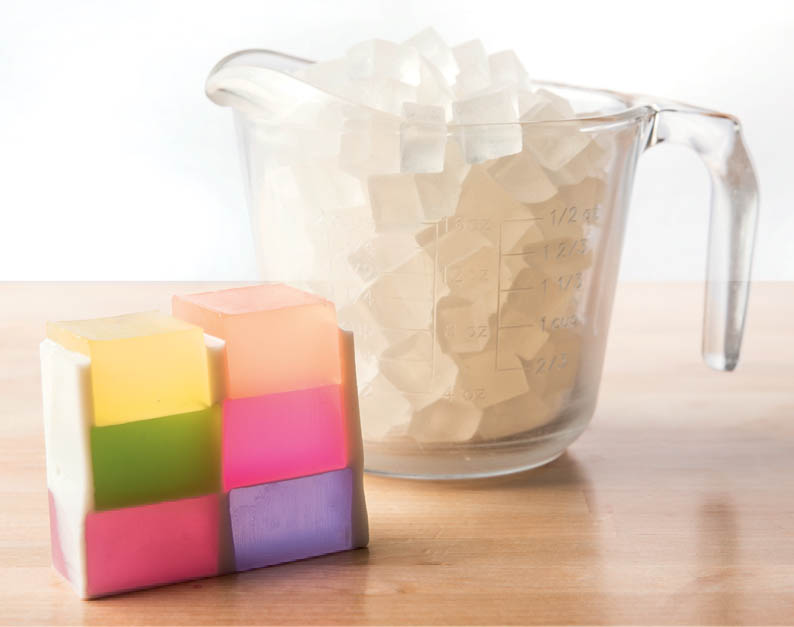
Melt-and-pour soap base
The hot-process method of soapmaking is similar to the cold-process method in that you start from scratch, which allows you to choose from a wide range of ingredients, and you use lye. However, as the name implies, this method involves the application of heat. With the hot-process method, you either cook your soap on the stove in a large stainless-steel pot or bake it in the oven (keeping a close eye on it at all times) or use a slow cooker. Hot-process soap can be used immediately; however, without the 4- to 6-week curing and drying time used in the cold-process method, the bars are softer and do not last as long in the shower.
Cold-process method. A soapmaking process that involves mixing a fixed oil or a combination of fixed oils, such as coconut oil, olive oil, and palm oil, with an alkali (in this case, sodium hydroxide, commonly known as “lye”). The resulting chemical reaction, saponification, turns the mixture into bar soap.
Essential oil. Oils that are extracted from natural elements, typically citrus peel, leaves, flowers, stems, bark, and herbs.
Fatty acids. A carboxylic acid that can be either saturated or unsaturated. An oil’s fatty acid profile determines its performance in a bar. For example, palm oil is high in palmitic and oleic acids, which contribute to hardness and a creamy/stable lather.
Fixed oil. A nonvolatile oil of plant or animal origin, typically of a high fatty acid profile.
Fragrance oil. A synthetic blend of aroma chemicals and essential oils created specifically for its scent profile. While fragrance oils may contain natural elements, they are not considered natural ingredients.
Gel phase. A temperature phase that occurs during the soapmaking process. Once soap is poured into its mold, the chemical reaction of saponification causes temperatures to rise, resulting in a translucent look that turns a shiny opaque after it cools. To gel or not to gel is a matter of personal preference.
International Nomenclature of Cosmetic Ingredients (INCI). A standardized list of scientific names for nearly 20,000 ingredients used in cosmetics; maintained by the Personal Care Products Council. INCI names are the formal terms for ingredients that are used on labels.
Lye calculator. A tool, easily found online, used to calculate the amount of lye and water need to saponify the oils in your recipe, based on each oils’ SAP value.
Lye discount (superfatting). To reduce the amount of lye by a certain percentage in order to leave unsaponified oils in a bar of soap for added skin-nourishing properties. The common discount (or superfat) rate is between 3 and 10 percent.
SAP (saponification) value. The amount of lye needed for fixed oils to saponify, or become soap. This number varies based on the fixed oil.
Saponification. The chemical process that results when a fixed oil or combination of fixed oils is mixed with an alkali such as sodium hydroxide (lye).
Sodium hydroxide (lye). A highly caustic alkali (NaOH) that when mixed with fixed oils causes saponification.
Superfat. See Lye discount.
Water discount. To reduce the amount of liquid called for in a soap recipe (typically by 5 to 15 percent), thereby lessening drying time. The higher the water discount, the more likely the soapmaker is to experience accelerated trace.
Learning to make cold-process soap is a bit like learning how to cook, with one major exception: the safety precautions are more serious. One of the main ingredients in cold-process soap is sodium hydroxide (lye), a caustic material commonly used to clean drains, brine lutefisk, and, believe it or not, help make that nice crunchy crust on pretzels.
Children and pets have no place in cold-process soapmaking. If you have small children, the safest place for them to be while you are making soap is out of the house. Fresh soap looks remarkably like cake batter, and little hands can be lightning fast when sugar appears to be involved.
As for animals, lock them outside or in another room. All it takes is one jump up on the counter to result in lye-water or fresh soap splatters all over you, your animal, and your countertops.
Keep your family and pets safe: make soap only with children and animals in another room or out of the house.
You can buy powdered, flaked, or beaded lye over the counter in many hardware stores and in the cleaning section of most big grocery stores. Typically, chemical supply stores or online vendors catering to soapmakers are more reliable sources. If you buy lye over the counter, make sure it is 97 to 99 percent pure and has no additives. Some popular drain cleaners have bits of aluminum added to them that are harmful to the soapmaking process. However you purchase your lye, you must treat it carefully.
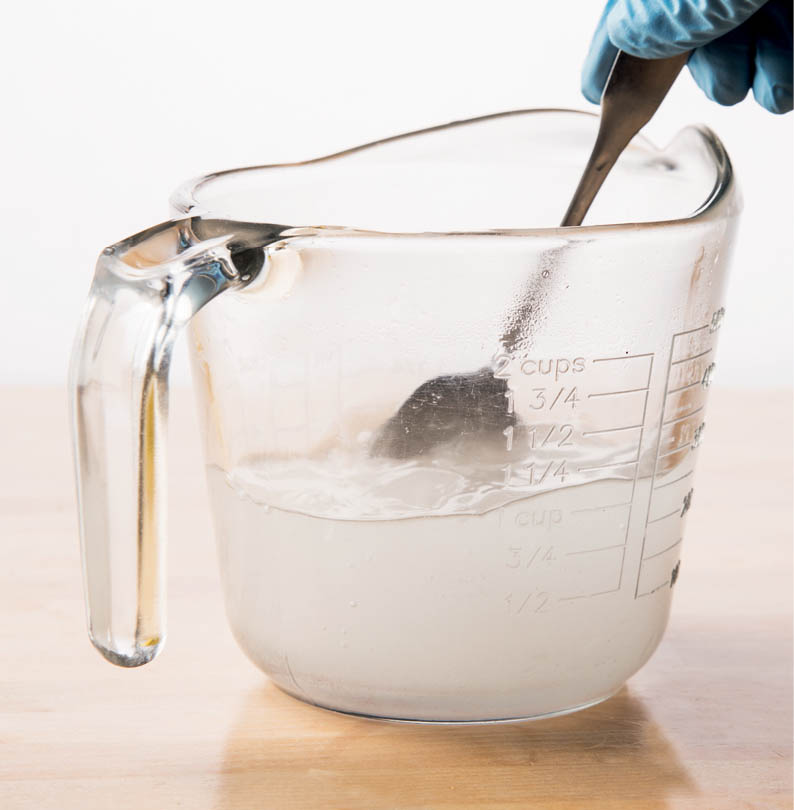
Lye-water is cloudy when first mixed.
When you are making soap, it is important to take safety precautions. Here are the basics.
Protect your eyes. While your skin acts as a protective barrier on your body, your eyes have no such natural protection. Lye can cause permanent damage. Dry lye, lye-water, and fresh soap can all cause irreparable harm if they get into your eyes, so use goggles or a full facial mask at all times when working with lye or fresh soap batter. Eyeglasses are not adequate protection.
Wear gloves. Lye-water or fresh soap batter can sting, burn, or cause red welts if it comes into contact with your skin. The area underneath your fingernails is especially sensitive. Spilling lye or fresh soap on even minor wounds is extremely painful. I recommend wearing gloves not only during the soapmaking process but also during the cleanup process.
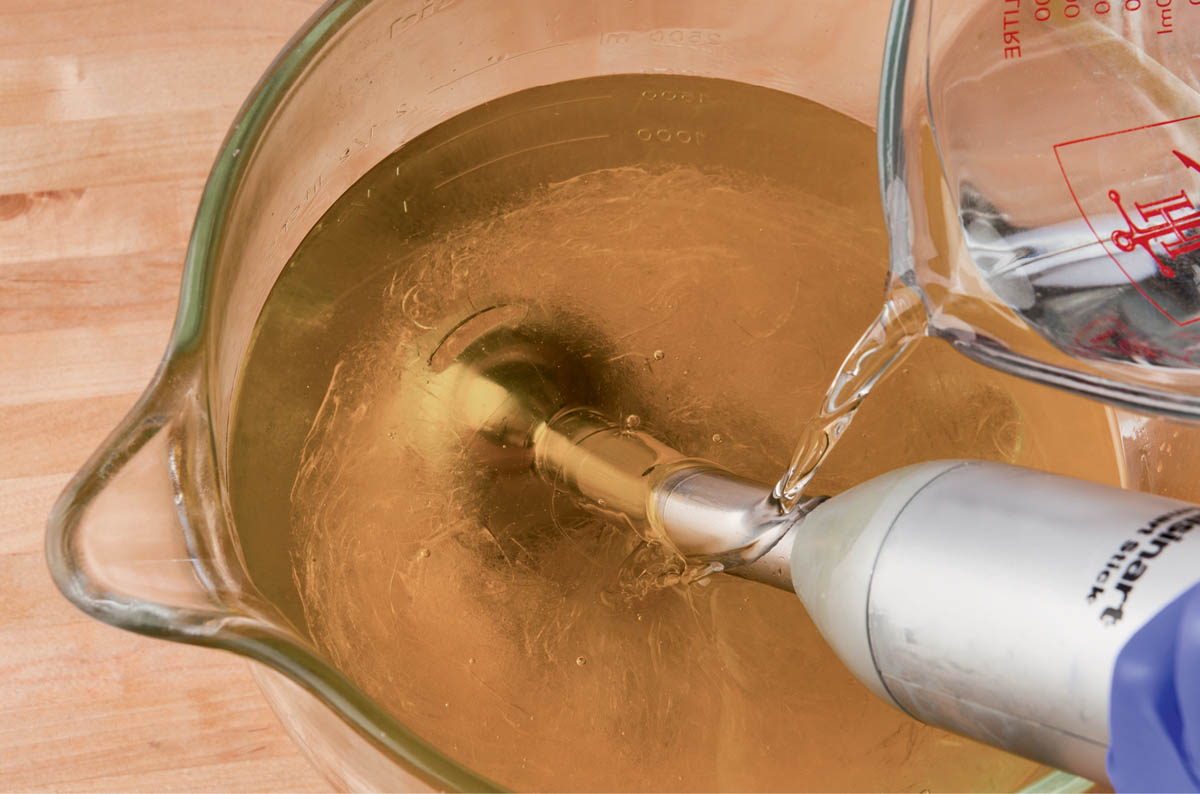
When making lye-water, always pour the lye crystals into the water; pouring water onto the lye could cause an explosion. And always pour the lye-water into the oils over a spoon, spatula, or stick-blender to avoid splashing.
Wear long sleeves and pants. Contact with lye-water or fresh soap will, at best, itch and irritate skin and, at worst, cause serious burns. Best practices involve wearing long sleeves and long pants during the entire soapmaking and cleanup process. And, of course, never make soap unless you’re wearing closed-toe shoes.
Avoid all contact with aluminum. Aluminum will ruin your soap, but more important, it creates a danger to you. The reaction between aluminum and lye creates hydrogen, a highly flammable and explosive gas. Check your utensils and bowls carefully, and use only stainless steel, heat-safe plastic, or heat-safe glass for soapmaking.
Work in a properly ventilated area. You do not want to breathe in any lye fumes. Some soapers wear full face masks because they want extra protection or because they are particularly sensitive to lye fumes. If you are soaping in a kitchen, open the windows and run a fan. If you must make your soap in a small, enclosed space, mix the lye-water outdoors to avoid breathing the fumes. Working in a large, well-ventilated room and mixing at full arm’s length is enough for me, but if your lungs feel irritated or you are coughing, it’s time to add more ventilation or protection.
Every soap recipe calls for a certain, specific amount of lye. Determining how much lye to use with your recipe is simple if you have access to a computer. If you do not have a computer, you need to do some math. But don’t worry, I’ll teach you how to make the calculation by hand too.
Each oil has its own saponification (SAP) value. This is the amount of lye that is needed to turn 1 gram of that oil into soap. For example, the SAP value of coconut oil is commonly given as .178, meaning that it takes .178 gram of lye to turn 1 gram of coconut oil into soap.
Although SAP values for various oils have been calculated in grams, you can still use those values when your ingredients are measured in ounces. For example, to figure out how much lye you would need for a recipe containing 10 ounces of coconut oil, take the SAP value of coconut oil (.178) and do the math as follows:
10 ounces of coconut oil × .178 SAP value = 1.78 ounces of lye
When you look up SAP values on the Internet, you will often find a range. For example, you may find that the SAP value for coconut oil on different charts varies from .178 to .191. Picking a number safely in the middle of the range is a commonly accepted practice.
If you use the exact amount of lye that the SAP value calls for, the resulting soap will have zero percent “superfat,” or unreacted oil. Most soapers choose to use slightly less lye than the recipe calls for in order to give their soap some degree of superfat. For example, if you use 5 percent less lye than the recipe calls for, your soap will have 5 percent superfat (also referred to as a “5 percent lye discount”). This extra oil moisturizes and nourishes the skin.
But you can have too much of a good thing: excess unreacted oil in your soap weighs down the lather and softens the bar. Additionally, the extra oil will go rancid sooner than the oil that has been turned into soap. Keeping your superfat to below 10 percent will ensure that your soap lathers well, lasts a reasonable amount of time in the shower, and has a long shelf life.
If you would like to use a wide variety of oils, you can calculate your recipe by hand using the SAP values listed in chapter 4. Or you can say a thankful prayer that computers exist and find an online lye calculator. The following three soapmaking websites contain widely used calculators:
The calculators all work a little bit differently, but the basic principles are the same.
Some lye calculators will also give you a range for how much water you can use. If you use less than 100 percent of the water recommended, this is called a water discount. Soapers often use a water discount to shorten the drying process. The less water in the soap, the faster the soap will harden. Discounting the amount of water in the recipe also reduces the time it takes for the water-lye-oil mixture to reach trace in your soap pot. For new soapers or those working with complicated designs such as swirls, this is not a positive thing: producing the trace quickly may not give you enough time to achieve the effects you want. The highest water discount you should use in any recipe is 50 percent, and if you discount that much, be prepared for a fast trace (or time from soap pot to mold).
Tip: Any time you make a new recipe, even if it is from a trusted source, run the recipe through a lye calculator just to be on the safe side.
Skin. If you spill lye, lye-water, or fresh soap on any part of your body, rinse, rinse, rinse with cold water. And then rinse some more. Soap and water are your friends when mitigating chemical burns from lye.
If you spill a large amount of lye-water or fresh soap on yourself, strip out of your clothing and immediately jump in the shower. Rinse with cold water for 20 minutes, and then use soap and water to get the last of the lye off.
If you have red or painful skin after that, go to the emergency room.
Eyes. If you get lye, lye-water, or fresh soap in your eyes, immediately flush them with running water. Remove any contact lenses and continue to flush your eyes with water for at least 20 minutes. Seek medical attention promptly.
Throat. If you swallow lye, lye-water, or fresh soap, rinse your mouth and then drink one or two glasses of water. Do not induce vomiting. Seek immediate medical attention or call the American Association of Poison Control Centers at 800-222-1222.